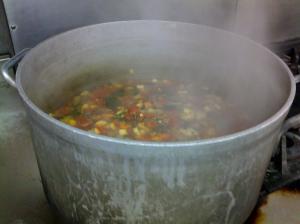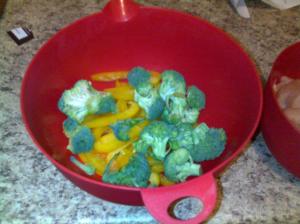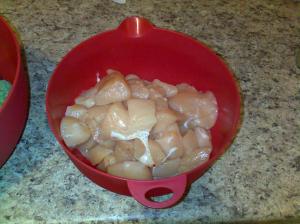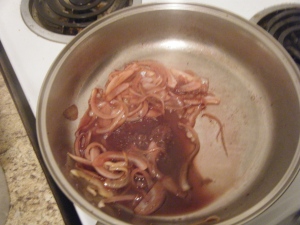As far back as I can remember, I always wanted to make minestrone.
Obviously I’m going to be writing about soup, again. Remember what I said last time about leftovers? Well, this one is exactly what you need to get rid of all those random bits of leftover veggies. Seriously, it almost makes no difference what it is. What I’m talking about is minestrone. Its a classic Italian soup. Minestrone means big soup, and it is certainly big on flavor. There is no standard recipe, and varies from family to family. Traditionally, it will have beans, but they are not a requirement. Today I made a lot of minestrone. This soup can very easily be made vegetarian or even vegan, depending on what you have around the house, and what you want to put in. This is a vegetable soup, but it doesn’t have to be a vegetarian soup. Through history meat wasn’t eaten as much as it is now, but it was eaten, and probably by almost everyone. In a soup like this pancetta is used to flavor the soup, but it is a minor component in the actual ingredients of the soup. If you don’t eat meat, leave it out.
Today I made a lot of minestrone. This soup can very easily be made vegetarian or even vegan, depending on what you have around the house, and what you want to put in. This is a vegetable soup, but it doesn’t have to be a vegetarian soup. Through history meat wasn’t eaten as much as it is now, but it was eaten, and probably by almost everyone. In a soup like this pancetta is used to flavor the soup, but it is a minor component in the actual ingredients of the soup. If you don’t eat meat, leave it out.
2 TBSP olive oil
1/4 inch thick slice pancetta, diced
1 medium onion, medium dice
1 carrot medium dice
1 stick of celery, medium dice
4 cloves of garlic, minced
1 TBSP crushed red pepper
Salt and pepper
1 can of diced tomatoes
1 cup white wine
1 bay leaf
1 TBSP herbes de provence
Now, once you get to this point you’ll want to just eat it, but don’t! This is kind of the base of the soup, so stick with it!
So, what do you have in the fridge?
Green beans? Corn? Gluten-free pasta? Kohlrabi? Broccoli? Cauliflower? Kale? Spinach? Zucchini? Squash? A can of canellini beans?
You’re also going to need some chicken stock or vegetable stock.
Ok, so lets get started. You have everything cut up? In a large pot, heat your oil, and then add the pancetta if you’re using it. With the pancetta you just want to render it over medium heat, until it is browned but not crisp. Next, add the onions, carrots, celery, garlic, and crushed red pepper. Add a little salt, and sweat this over medium heat until the onions have started to turn clear.
Add the tomatoes, mix them in, and add the wine, and herbs. Add the stock, bring it up to a boil, and then depending on what veggies you have to put in the soup start adding them. You’ll want to make sure that you add things that will take longest to cook earliest. As you simmer the soup add things, keeping in mind how long they will take to cook. The last thing I would add would be something like beans or pasta. Beans and pasta taste great, but they tend to soak up liquid, and swell up. They can very easily take over a pot of soup so add way less than you think you should!
That is really all it takes to make great minestrone. No recipe at all, just go, and cook it. Now, for the funny part… I actually adapted this from a cookbook! Henry Hill wrote a cookbook based on his life, and its called the Wiseguy’s Cookbook. If you are a fan of Italian food, as well as the movie Goodfellas you’ll want to get a copy of this book. There are lots of recipes, and its got some pretty interesting stories as well. Not all of them are gluten-free, but a lot of them can be made gluten-free with a little playing around.
I don’t have to Pei my own Wei for Spicy Chicken!
As far as my food preferences go I tend to like spicy food, although not all the time. One of my favorite things before going gluten-free was to go get Chinese at one of several local carry-out places. One of my go to dishes was General T’so’s chicken, spicy, and sweet is one of the flavor combinations that I really dig. As we know, Chinese food is generally off limits due to soy sauce. Needless to say, I was bummed. PF Chang’s and its sister Pei Wei have made our lives a little easier as far as Chinese carry-out. After trying the Spicy chicken at Pei Wei I decided I had found a suitable replacement for General T’so! Not quite the same, but it will do. After a few trips I recently realized that not only did I like it, but I was pretty sure I could come up with my own version for a lot less money, and cut out the trip.
This is going to be a bit of a multi-step thing, but they are easy. First thing you need to do is make your sauce. For most cuisines there are sort of base flavors that are commonly used. If you look at a lot of recipes of French dishes you will spot mirepoix which is simply 2 parts onion diced, and then one part each of celery and carrots. This becomes the trinity in cajun cooking be replacing the carrots with green peppers. Lemongrass and galangal are common in Thai dishes, and in Chinese garlic and ginger. I took the garlic and ginger as a base flavor, and built my sauce from there. Here’s what I came up with:
1 1/4 cup orange juice + lime juice to bring the total to 1 1/3 cup
1 TBSP sambal
1 TBSP honey
1 clove ginger crushed
1 quarter inch thick slice of ginger root
Place everything in a pot, and bring it up to a boil. Then take 1 TBSP of corn starch, and combine with enough orange juice to make a slurry. With the pot still boiling add the slurry while whisking. You don’t want clumps so, be sure you are mixing it while you pour. Remove it from the heat, and cool. Keep this in the fridge till you are ready to finish the dish. Really, that was it!
The next thing I did was get all of the other ingredients prepped. I had four chicken breasts, because I wanted leftovers for lunch for the next few days at work. I also had some broccoli, carrot, and yellow bell pepper. The chicken was cut into bite sized cubes, the broccoli I cut into florets, and the yellow pepper and carrot I sliced thinly.

From here this dish came together pretty much like my last stir-fry chicken post. Start with the chicken, and sauté until cooked nearly through. Then add the veggies, and cook until they are tender. Add the sauce to the pan, and stir to combine, and coat everything. Serve over rice, and enjoy! If you are looking for a vegetarian dish, substitute tofu for the chicken, but remember to get the firmest you can otherwise it will break up while you try to sauté it.
A little bit of analysis: Dinner was very tasty, but… not quite right. It was fairly mild, and not quite sweet enough. It was also not quite thick enough. I still have about half the sauce left, and I think my next step will be to add a bit more honey, sambal, and thicken the sauce a little bit more. It was fun to take a shot at reverse engineering a recipe from only tasting eating it. I’m on the right path, so I’ll keep going a little further. This was a little bit of a challenge just due to the fact that there is a fair amount going on in the sauce.
I hope that my experiment inspires you to see what you can do in the kitchen. All it takes is paying attention to what you are eating, and taking a shot at replicating what you taste. Remember that there is more to what you eat than just the taste. There is flavor, scent, and texture. See how close you can get!
If there is anything you would like me to take a shot at reply here, and I’ll see what I can do. I’d love to hear from you guys!
Let Them Eat Steak!
Happy belated Bastille Day! A while back I was asked by a friend to teach her to make a steak. I told her that I could make a better steak for less money than a trip to a local steakhouse. I don’t go out for steak, honestly, it is too easy to make at home, and you save a ton of money. I like strip steaks, they have good flavor, and are not too tough. Now, if you were to go to Outback, an 8 ounce strip steak will run you about $15. I bought mine at Schnucks for $4.75. Side dish type things are cheap, so I’m not even going to count them.
Before we even get into cooking a steak lets talk about how you know when it’s done. First, there is the easiest way. Cook the living shit out of the steak. Ok, no. Thermometer? Well, that works, but then you have to remember the temperatures for the different donenesses of your steaks. The other down side of that is that you are poking a hole in your steak for all of the juices to run out of. That is not good. Even if you like your steaks well done they can still be juicy. The best way and the easiest is to poke it with a finger. Here’s how it works, take your left hand and hold your index finger and thumb together, then poke the pad of your thumb with your other index finger. That is rare. Medium rare? Middle finger and thumb. Medium is the ring finger, and well done is(burned) your pinky.
Now, the first thing you want to do is get your steak out of the fridge, and set it on the counter for about a half hour. You probably should also get your oven warmed up (350F), and you could even put your skillet in it to get it hot too . I wanted to have a little pan sauce for fun, and since I had some red wine, onion and chicken stock I was set.
Season your steak on both sides with salt and pepper. That is all you really need. Buy a decent cut of steak, and make it thick enough that you can cook it without worrying that you will end up with a piece of shoe leather. I know a lot of people love fillet mignon, but at $24/pound it is a bit pricey, and what are you getting? Sure, it is tender, but it is also a muscle that doesn’t do much work, and doesn’t really have much in the way of flavor. Sirloin is a bit too fatty for me, but it is a nice cut. Everyone has different preferences, so try a few, and find what you like. I like a strip steak, they taste great, and aren’t super fatty. I keep things simple and stick with salt and pepper, and I don’t see a point in marinades. If I want a steak I want it to taste like a piece of beef, not teriyaki.
So, you’ve got a steak that you seasoned with salt and pepper, and a hot skillet. Get the skillet on the stove top(turn the burner on), and put a small amount of oil in it. Let the oil get hot. When you tilt the skillet you should see ripples in the oil before you even think about putting the steak in there. When you put your steak in the pan, leave it alone. You are NOT sauteing here, you are searing. After a minute or so, gently shake the skillet. If it doesn’t move leave it alone. If it moves a bit, gently turn it over. Tongs are best for this sort of thing.
Now, put the steak in the oven. Here’s where things get a little tricky. How long? That depends on a lot of factors. How thick is the meat? What shape? How do you like it? Give it a few minutes, and check. That is all I can tell you. Thicker steaks will take longer. If you skipped the take it out of the fridge step, it will take longer. The onus is on you to make your steak the way you like it. Remember that practice makes perfect, and the more often you do this the better you will be.
Done enough? Ok, take it out of the skillet, set in on a plate to rest, and cover it with a piece of foil. This is important. It won’t get cold. It’s now time for our pan sauce! I julienned about half an onion. Pour out most of the fat from the skillet, and put it back on the stove. Put the onions in and saute them until they are tender and starting to caramelize. You’ll notice that there was some brown stuff left by the steak(Its called fond), the onions will get some of that out of the pan. Then I poured a small amount of red wine in the skillet with the onions. Then stir making sure to sure that all of the brown bits come out of the pan. I let it reduce a bit, and added some chicken broth. Again, let it reduce. I did that just to mellow out the flavor of the wine. When I got it reduced I added maybe a teaspoon of soft butter to the sauce, and mixed it in. That is the sauce for my steak, and it tasted much better than any of the steak sauces you buy in the store.
Once the sauce was finished I simply spooned the sauce over the steak and enjoy!




